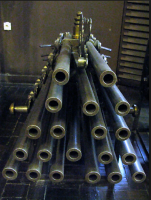








A volley gun is a gun with several barrels for firing a number of shots, either simultaneously or in sequence. They differ from modern machine guns in that they lack automatic loading and automatic fire and are limited by the number of barrels bundled together.
The ribauldequin was the earliest attempt at a volley gun. Also known as an “infernal machine” or an “organ gun” (because its barrels resembled the pipes of a church organ), ribauldequins were made up of many small caliber cannons laid side by side on a flat platform. When the gun was fired, it would spread a volley of cannon shot across the battlefield, chewing up everything in its path. The ribauldequin made its battlefield debut with the armies of Edward the III of England during the Hundred Years War. This first model, which appeared in 1339, featured 12 barrels. In subsequent decades, other versions of the ribauldequin with more barrels were used by medieval armies in Italy as well as in the War of the Roses.
More recently, a number of designs of electronically fired explosive-propulsion projectile weapons and non-explosive projectile weapons have been developed which have some similarities to 18th-century volley guns, particularly in that they use many barrels which can be fired all at once or in sequence such as the Nordenfelt gun. However, they are not as yet in general use.
Various forms of the weapon have been designed, including aircraft-mounted guns firing downward, man-portable artillery packs and defensive applications, such as ship-based anti-missile defense systems (for which Gatling guns are currently used).
The Spanish Navy also uses a volley gun system, the Meroka, which consists of twelve 20 mm cannon mounted in a tight cluster with an externally powered automatic loading system. It delivers an exceptionally high rate of fire for a very short burst, and reloads in less than 0.3 seconds. This makes it suitable for close-range defense against missiles, aircraft and small boats.